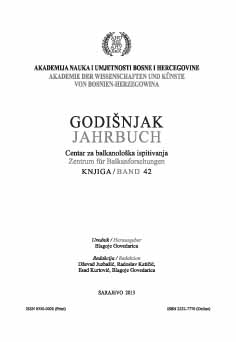Kroatizacija bosanskog srednjovjekovlja u svjetlu interkonfesionalnosti stećaka (O jednom modelu promjene historijskog pamćenja)
Croatization of the Bosnian Middle Ages in Light of the Religious Character of Stećak Tombstones (About a model of the changing the historical memory
Author(s): Dubravko LovrenovićSubject(s): History
Published by: Akademija Nauka i Umjetnosti Bosne i Hercegovine
Summary/Abstract: The nationalist approach to Croatianhood formed within the Croatian Party of Rights and and the concept of political Catholicism were both introduced into the Croatian historiography of Bosnia and Herzegovina at the turn of the 19th and 20th centuries. This phenomenon, along with a new historical perspective on Croatia as „mother-land“, led to attempts to Croatize the Bosnian Middle Ages. As a result, an extensive historiography was created with the aim of presenting the Bosnian Middle Ages as part of Croatian medieval national history. These efforts were also reflected in a false ethnic and religious attribution of stećaks – Bosnian medieval tombstones – which were and still are attributed exclusively to Croatians and Catholics. The extent of the Croatization of the Bosnian Middle Ages, and thus of stećaks too, changed with the changing political regimes. In the Austro-Hungarian period (1878–1918) two authors, Fran Milobar and Ivo Pilar, published books and articles based on the theory, propagated by the Croatian Party of Rights, about the „original territorial acquisition.“ They set up and developed a pseudoscholarly thesis about the ethnic and dynastic Croatian character of the Bosnian Middle Ages. During the first Yugoslavia (1918–1941) the thesis was picked up and further developed by Josip Horvat in his monumental synthetic work on a thousand years of Croatian culture. During the same period a number of articles were published in an issue of the People’s Calendar, put out by Napredak, the Croatian Cultural Society of Bosnia-Herzegovina, which propagated this historiographic error to a wider readership. During the quisling state called The Independent State od Croatia (Nezavisna Država Hrvatska, (1941–1945), the Croatization of the Bosnian Middle Ages was “standardized” in a publication produced by Napredak and entitled The History of Croatian Lands in Bosnia and Herzegovina from the Earliest Times until 1463; the main contributors were Filip Lukas, Oton Knezović, Ćiro Truhelka, Ljubo Karaman, Vladimir Vrana and Mate Tentor. The theory of Croatian Bosnia was also popularized through textbooks. Ante Pavelić, the head of The Independent State od Croatia, dealt with the same topic in his writings, using the Bosnian Middle Ages as the central motif. Particularly manifest in these writings are historiographical and geopolitical delusions concocted in order to legalize The Ustasa regime: 1. The Drina river – the civilizational boundary between two worlds in the context of national and ideological topography with the inclusion of the Drina river in the lyrics of the Croatian national anthem. 2. Croatians – the outer wall of Western Europe. 3. Iranian/Gothic origin of Croats. 4. The supposed centuries-old continuity of Croatian statehood as a legitimizing factor for The Independent State of Croatia. 5. Bosnia – body and heart of the Independent State of Croatia.
Journal: Godišnjak Centra za balkanološka ispitivanja
- Issue Year: 2013
- Issue No: 42
- Page Range: 103-129
- Page Count: 27
- Language: Croatian

